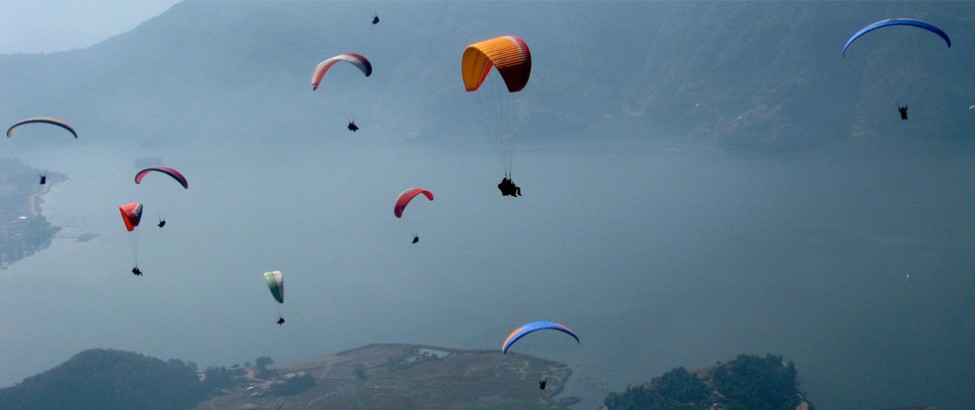Share this Article

Introduction
Nepal, renowned for its breathtaking landscapes and towering Himalayas, has become a global hotspot for adventure tourism. Among the many adrenaline-pumping activities, paragliding stands out as one of the most exhilarating experiences the country has to offer. With its favorable wind conditions, stunning panoramic views, and world-class take-off sites, Nepal has emerged as one of the top destinations for paragliding enthusiasts. This article explores the history, major paragliding locations, safety measures, challenges, and the impact of paragliding on Nepal’s tourism industry.
History of Paragliding in Nepal
Paragliding in Nepal started in the mid-1990s when foreign adventurers recognized the potential of the country’s unique geography. Over time, the sport gained popularity, attracting both international and domestic thrill-seekers. Today, Nepal boasts one of the best paragliding experiences in the world, with international competitions and training schools promoting the sport.
Best Paragliding Destinations in Nepal
Nepal offers several paragliding spots, each providing a unique experience. Below are some of the most famous paragliding destinations in the country:
1. Pokhara – The Paragliding Capital of Nepal
Pokhara is undoubtedly the most popular paragliding destination in Nepal. The Sarangkot hilltop, located at an altitude of 1,592 meters, serves as the primary take-off point. The flight provides mesmerizing views of Phewa Lake, the Annapurna mountain range, and the lush valleys below. Pokhara's stable weather conditions and thermal winds make it ideal for paragliding throughout the year.
- Best time to visit: September to April
- Flight duration: 20-60 minutes
- Types of flights: Tandem flights, solo flights, cross-country flights
2. Bandipur – The Hidden Gem
Situated between Kathmandu and Pokhara, Bandipur is a lesser-known but equally stunning paragliding destination. With its traditional Newari architecture, lush hills, and breathtaking views of the Himalayas, Bandipur provides a peaceful yet thrilling experience for paragliders.
- Best time to visit: October to March
- Flight duration: 20-40 minutes
3. Dhulikhel – Paragliding near Kathmandu
Located just 30 km from Kathmandu, Dhulikhel offers a perfect escape for adventure lovers who want to experience paragliding close to the capital. The flights provide a panoramic view of the Langtang and Gaurishankar mountain ranges, along with a scenic overlook of traditional villages and terraced fields.
- Best time to visit: October to February
- Flight duration: 15-30 minutes
4. Sirkot – The Emerging Destination
Located in the Syangja district, Sirkot is gaining popularity for cross-country paragliding. The region provides an extended flight duration with scenic views of the mountains, lush forests, and rural villages.
- Best time to visit: October to April
- Flight duration: 30-90 minutes
5. Tansen – The Cultural Adventure
Tansen, located in the Palpa district, offers paragliding with a blend of cultural and natural beauty. The flights provide a spectacular view of the Kali Gandaki River, the Mahabharat range, and the medieval town of Tansen.
- Best time to visit: November to March
- Flight duration: 20-40 minutes
Paragliding Experience in Nepal
A typical paragliding experience in Nepal involves the following steps:
- Arrival at the Take-off Site: Paragliders reach the designated take-off point, usually on a hilltop, by vehicle or hiking.
- Pre-flight Briefing: Professional pilots provide safety instructions, weather conditions, and basic flight techniques.
- Take-off: After securing the harness and equipment, the pilot and passenger run a few steps before being lifted into the air by thermal winds.
- Mid-flight Experience: While soaring through the sky, paragliders experience breathtaking aerial views, occasionally catching glimpses of birds flying alongside.
- Landing: The flight ends with a controlled descent to a designated landing zone.
Types of Paragliding Flights in Nepal
Nepal offers different types of paragliding experiences depending on skill level and interest:
- Tandem Flights: A professional pilot controls the glider while the passenger enjoys the view.
- Solo Flights: Experienced paragliders can fly independently after obtaining a proper license.
- Cross-country Flights: Advanced paragliders explore extended routes covering vast landscapes.
- Acrobatic Flights: Thrill-seekers can experience maneuvers like spirals and wingovers.
Safety Measures and Regulations
Safety is a priority in paragliding, and Nepal has established guidelines to ensure secure flights. Some key safety measures include:
- Weather Monitoring: Paragliding is only conducted in stable weather conditions.
- Certified Pilots: All tandem flights are operated by trained and licensed pilots.
- Quality Equipment: Paragliding operators use internationally approved safety gear.
- Insurance: Most tour agencies provide insurance coverage for accidents.
- Training Schools: Beginner courses are available for those who wish to learn solo paragliding.
Challenges and Concerns
While Nepal offers an exceptional paragliding experience, several challenges affect the industry:
- Unpredictable Weather: Sudden changes in wind patterns can make flights risky.
- Limited Infrastructure: Some paragliding sites lack proper access roads and emergency services.
- Overcrowding in Pokhara: The increasing number of paragliders can lead to congested airspace.
- Environmental Concerns: The growing tourism industry can impact the natural ecosystem.
Economic and Tourism Impact
Paragliding has significantly contributed to Nepal’s tourism industry by attracting thousands of adventure seekers annually. The economic benefits include:
- Employment Generation: Many locals work as pilots, instructors, and tour operators.
- Boost to Local Economy: Increased tourism benefits hotels, restaurants, and transport services.
- Promotion of Adventure Tourism: Paragliding helps Nepal establish itself as an international adventure tourism hub.
Future Prospects and Sustainable Growth
To ensure sustainable growth, Nepal needs to focus on:
- Expanding Paragliding Locations: Developing new sites to reduce overcrowding in Pokhara.
- Improving Infrastructure: Building better roads and emergency facilities near take-off sites.
- Environmental Conservation: Implementing eco-friendly tourism practices to protect nature.
- Stronger Regulations: Enforcing stricter safety standards and licensing procedures.
Conclusion
Paragliding in Nepal is more than just an adventure—it is a chance to soar above the world’s highest peaks and experience an unparalleled sense of freedom. With its perfect combination of stunning landscapes, expert pilots, and favorable weather conditions, Nepal has rightly earned its reputation as one of the best paragliding destinations in the world. While challenges exist, sustainable tourism efforts can ensure that future generations continue to enjoy this incredible experience. Whether you're a seasoned paraglider or a first-time adventurer, Nepal’s skies are waiting to take you on an unforgettable journey.
Categories:
Adventure Activities
Tags:
ParaglidingNepal
,
FlyNepal
,
ParaglidingAdventure
,
SoarAboveTheHimalayas







